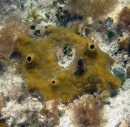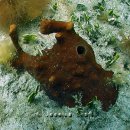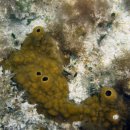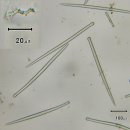| Common names: |
Brown variable sponge, Brown volcano carpet sponge. |
| Growth Form: |
Thin to thick encrusting, irregularly massive, hemispheric, globular, or partly divided into irregular lobes; often with irregular finger-like or branching processes (fistules) 0.5-5 cm thick. Encrusting patches often rounded or semicircular, covering up to 1 m2. |
| Surface: |
Smooth and non-porous but typically with irregular bumps or lobes; surface feels rough. Often partly covered by sediment. |
| Color: |
Variously yellow, tan, green or brown; commonly dark mustard brown in South Florida; may be somewhat mottled. Thin encrusting form may appear dark green. Paler yellowish inside. A dark brown hemispheric form is orange inside. Colors remain in alcohol. |
| Consistency: |
Firm to hard rubbery; crumbly at the surface. Erect forms may be especially rigid (forma rigida). |
| Exudate: |
None. |
| Oscules: |
Round, irregularly distributed (0.5-2 cm across) with thin marginal membrane paler than surrounding tissue or white; elevated well above surface and often on top of lobes or lumps. Larger oscules have interior subdivisions (compound). Oscules may not be obvious in small specimens. |
| Skeletal components (Spicules, fibers): |
Straight smooth rods with one end bluntly pointed and the other end distinctly swollen (tylostyle), 150-500 x 3-15 μm. Small spicules are spirals with 2-3 bends up to 20 μm long, with often knobbed or branched spines (spiraster) that are characteristically abundant on the outer curves (specifically called anthosigmas). No spongin fibers. |
| Skeletal Architecture: |
No special exterior skeleton. Spicule bundles from the interior form a palisade with pointed ends slightly piercing the surface. Microscleres are especially abundant among the palisades. Many small interior holes and canals (microcavernous structure) with spicules densely strewn in confusion and not forming a skeletal meshwork. |
| Ecology: |
Common on coral reefs, reef flats, sea grass beds and lagoons, burrowing into dead coral framework, occasionally attacking live corals; excavating shallowly into the substrate. |
| Distribution: |
South Florida and throughout the Caribbean, from the low tide mark down to at least 41 m. |
| Notes: |
An encrusting to massive excavating sponge with yellowish or greenish color lacking papillae is almost certainly this species. The small anthosigma spicules are unique and diagnostic. Chondrilla caribensis may resemble lumpy, lobate, similarly colored Cliona varians, but is cartilaginous and slippery to the touch, not rough. Rare globular or hemispherical individuals may resemble Stelletta kallitetilla, which is light tan with a lumpy surface, but bears depressions and holes unlike Cliona varians. Pale specimens of Spheciospongia vesparium may look superficially similar, but bear pores and oscules concentrated in sieve-like groups. The thin encrusting form is sometimes named Cliona varians forma incrustans. This species was formerly called Anthosigmella varians. |
| References: |
Wiedenmayer (1977), Vicente (1990), Hill & Hill (2002). |
| Similar species: |
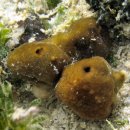
Chondrilla caribensis |
|


